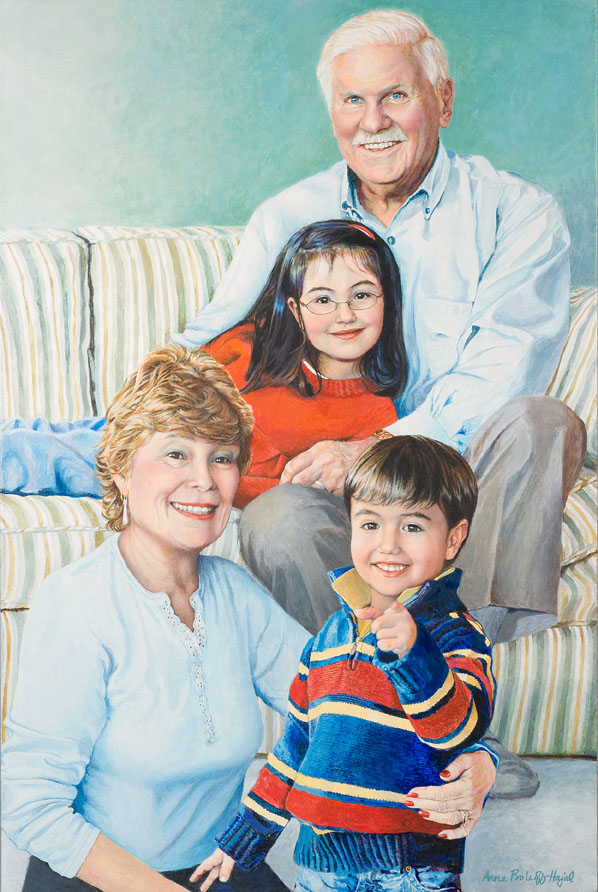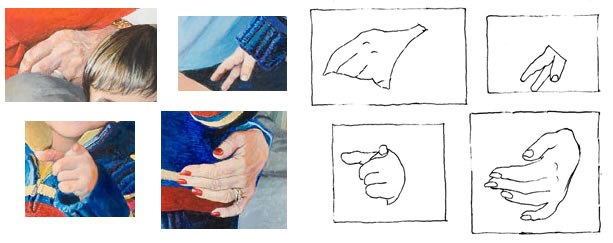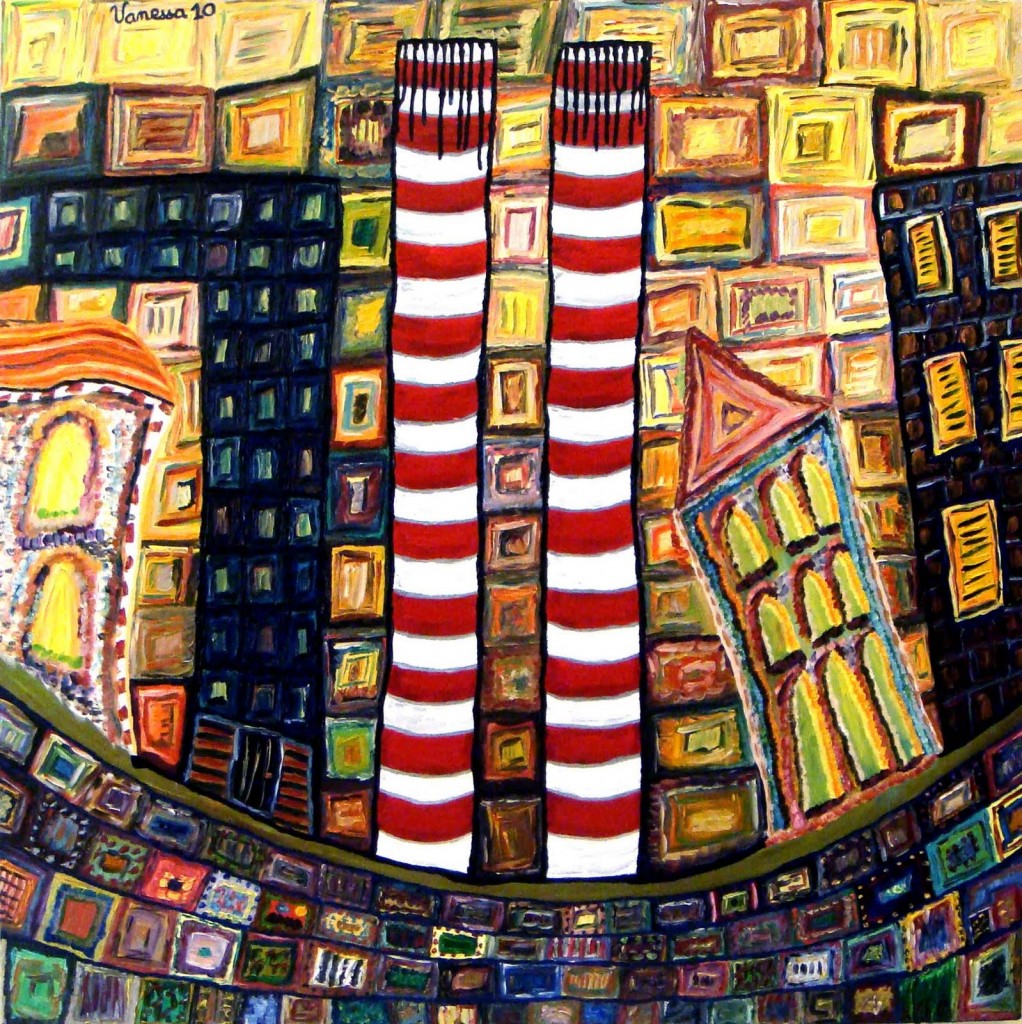Why do our brains withhold from our conscious grasp a way of seeing that’s so useful? Why aren’t we able to easily dip into that mode of seeing when we want it to draw?
When I posted a two-part online drawing lesson a couple of months ago, I received a response that got me wondering.
The response was from a wonderful young Lebanese artist, Vanessa Gemayel. Vanessa paints luminously about today’s destruction of the beautiful traditional architecture that gave Beirut its unique atmosphere, replaced by generic modern architecture that is sadly making Beirut look like every other city in the world.
Vanessa, after trying out my figure-drawing lessons, wrote to me that she found them “very cool and helpful.” But, she added, “you make it seem a lot easier than it actually is.” And of course Vanessa is saying outright what many people feel about drawing instruction.
That got me wondering what in the human brain makes drawing from life so not-easy to learn.
All jobs involve a learning curve, often long and hard to get through. Drawing from life is in that sense no different from any other expertise. Many skills, for example, require years of study before mastering them. Others need endless practice.
I believe that the most important element of learning to draw, though, is an “aha moment” – or maybe a small series of such moments. In those few moments, you suddenly start being able to see in a different way which enables you to draw realistically. This alternate way of seeing is for me, and for many who draw, the single most basic and important tool we use.
True, endless practice must follow the aha. But the practice isn’t what blocks most people who really want to learn to draw.
In learning to draw, I think what is elusive to many people is the “aha moment” when they begin to see in that all-important alternate way.
With that aha, you will be able to learn to draw easily.
What is the aha moment in learning to draw?
In my drawing-lesson posts, “Learning to Draw by Playing the Angle Abstraction Game,” I called the technique of seeing differently “angle abstraction.” The artist is able to see what they’re drawing as a series of angles and shapes that are much easier to draw than when their subject is seen “normally.”
Other artists have given other names to their alternate way of seeing. Betty Edwards has written two groundbreaking books in which she calls it “right-brain mode,” or “R-mode” (as distinct from left-brain mode, or L-mode).
L-mode is how we consciously think in our everyday lives. It’s language-based.
R-mode – the one that enables us to draw – is non-verbal and does its work mostly outside our conscious awareness.
The “aha moment” happens when you are suddenly able to consciously access and use R-mode to see differently and draw.

One frame from my free online drawing lesson, "Learning to Draw by Playing the Angle Abstraction Game"
But why would our brains withhold from our conscious grasp a way of seeing that can be so useful? Why shouldn’t we all be able to easily dip into that mode of thinking when we want it to draw?
Why do our brains block our aha moments?

Portrait of the Steinbergs, by Anne Bobroff-Hajal. Notice how different each of the hands looks.
I was pondering this question when I recently ran into a wonderful answer in one of Betty Edwards’ books, Drawing on the Artist Within (p. 208).
One way of conveying Edwards’ explanation here is through a group portrait I painted (right) of Bob and Gail Steinberg with their grandchildren, Riley and Alex. This portrait illustrates one of the classic problems of drawing: how to draw parts of the human body when they are foreshortened – that is when they are coming straight at us, so they look very different from what we usually think of as an arm, a leg, a hand.
The most obvious foreshortened body part in this portrait is the hand of the Steinbergs’ grandson Alex, who is pointing directly at the viewer. Everyone who sees this painting knows exactly what that hand is doing. But in fact, it bears little resemblance to our standard concept of what a hand looks like. Our conscious, rational L-mode brain typically thinks of a hand as something more like the father’s hand in another portrait (below).

Detail of Edwin Ermita and Two of His Children, by Anne Bobroff-Hajal
That little pointing finger
Alex’s pointing finger appears on the canvas as a small circle, not the long tube shape we associate with fingers. That’s strange enough. But beyond that, the thumb seems bigger than the other fingers. And it stretches out at an angle that we rarely think of thumbs taking on. That thumb seemed so odd to me while I was painting it that I rechecked it multiple times to be sure I had it right.
In fact, it’s exactly because I allowed each finger to take on its actual shape – rather than what I might have consciously thought it should look like – that makes it possible for everyone who looks at the painting to know exactly what that strange conglomeration of flesh-colored blobs is.
Now for the other hands….
In addition to the little pointing finger, we can look at the other hands in the Steinberg portrait. When we really study them, none of them is shaped like our standard concept of a hand.

Detail of Steinberg portrait hands, along with black ink outline of each
Bob Steinberg’s hand appears almost triangular, with only parts of four fingers visible.
Little Alex’s right hand is visible as only a thumb and two fingers. And the index finger looks like it’s separated from the thumb by an interloping finger which in reality is farther away from the thumb.
Gail Steinberg’s fingers conform fairly well to our standard image of a hand. But what about the back of the palm area? It looks much smaller and less rectangular than it “should.”
It’s fine for us to view these shapes as being all different when we’re drawing. But it’s also crucial for our daily functioning that we recognize all of them as the same – as hands. It’s the job of our efficient, everyday L-mode, says Edwards, to quickly classify all these odd shapes under the general verbal rubric of “hand.” And that verbal rubric is envisioned as in Edwin Ermita’s hand above, stretched flat, with five fingers roughly the same length as the palm.
If our brains had to go through a conscious, verbal process of debating whether each of a group of very dissimilar objects is or is not a hand from a different angle, we’d never get through our day. We’d be mired in endless debating: “I see three of what look like fingers, two from the side and the third, a thumb, from more of a straight-on view. But if they are fingers, why aren’t there five of them, and why aren’t they attached to a hand? Is the hand out of my sight, or ….”
Our unconscious interpreter
It’s R-mode, says Edwards, that takes in all the differences in shape and size, and, with lightning speed, calculates from them where things are in space, what they are, and so on. R-mode sees, for example, that the back of Gail Steinberg’s hand appears to be getting smaller not because it is smaller, but because it’s receding back from her fingers, curving around Alex’s body. “It’s a hand, all right,” says R-mode, “it’s just shaped differently from a “standard” one because its wrist is farther away from us than its fingers.”
Edwards wrote (p. 178),
“R-mode apparently computes instantaneously and nonverbally…. This computation – and the size-change information that hits the retina – is somehow kept ‘secret’ from conscious awareness, perhaps in order not to interfere with or complicate the language system.”
I suspect this instantaneous computation is also “kept secret from conscious awareness” because language – the currency of L-mode – would slow down its lightning speed. The rapidity with which our R-mode calculates that a flesh-colored circle is a finger pointing at us happens far faster than we could ever describe in words.
An analogy that might make this clearer is of an athlete hitting a ball. The athlete’s R-mode brain is making calculations at phenomenal speed about how far away the ball is, how fast its moving, where its moving, and about how the athlete him/herself must move and react to all that information in order to successfully connect with the ball. If the athlete had to bring all of this to consciousness and calculate it verbally – “the ball is now curving right and I can see it will bounce in this particular way, so I calculate that I should move this way – no, I now see that it had spin on it, so I need to redo my computations…” – the athlete would never be able to hit the ball before it went whizzing past.
Bringing the aha to more readers
When artists draw, I believe they are making judgments and decisions at that same lightning speed as the athlete hitting a ball. Their thought process has to be non-verbal because of the countless calculations made in a split-second’s time.
I think this is why it’s so difficult to convey drawing instruction in words. The artist’s observations, judgments, and decisions happen in a split second of often-exciting non-verbal discovery. But to convey to a reader that same thought process takes long paragraphs of verbiage. That’s why I’m hoping to be able to get more video drawing demos up on this blog in future – along with text that tries to convey a small fraction of the artist’s split-second decision-making as he or she works.
We need language to communicate the artist’s process to other people. But language is slower and more reductionist than some other processes in our brains. Hopefully a combination of images, video, and language will bring the aha moment to more readers of this blog in the future.





















21 Blackjack
Jachpot
coursework phd nea coursework history a level coursework handbook qmul coursework extension
10 e lotto onlain
Giochi pazzi
купить авиабилеты ютэйр официальный
купить авиабилеты на самолет красноярск
путаны москва
娛樂城
dạng Đầu Tư Định Cư Hy Lạp 2023
chuyên gửi hàng đi mỹ 2023
We’re a bunch of volunteers and opening a new scheme in our community.
Your website offered us with helpful info to work on. You have performed
a formidable activity and our entire group will be grateful to you.
cogan 33
orthopedic supply stores near me
hi!,I like your writing very a lot! percentage we keep up a correspondence extra approximately your post on AOL?
I need an expert in this area to unravel my problem. Maybe
that’s you! Looking ahead to look you.
https://www.mytek.tn/sports-loisirs/glisse-urbaine/trottinette.html?type_de_trottinette=13241
buy levofloxacin pills levofloxacin 250mg without prescription
прямой рейс авиабилеты купить без пересадки
online pharmacies in usa best ed medication
https://ladyfirstportal.ru/
Smartphone OPPO
Carte Graphique Radeon RX 6700 XT
Hey I know this is off topic but I was wondering if you knew of any widgets I could add to my blog that automatically tweet my newest twitter updates.
I’ve been looking for a plug-in like this for quite some
time and was hoping maybe you would have some experience with something like this.
Please let me know if you run into anything.
I truly enjoy reading your blog and I look forward to your new updates.
https://vulgarblog.ru/
10 e lotto immediato
10 e lotto immediato
займ на карту быстро
When someone writes an paragraph he/she retains the image of a user in his/her brain that how a user can understand it. So that’s why this piece of writing is perfect. Thanks!
10lott0
Planet 365 Casino
Бальзамы для губ купить
A mothers heart is always with her children.
Славное онлайн толпа да покер-рум Pokerdom, начавший свойскую увлекающуюся деятельность на 2014 году, зовет свой в доску клиентам широченный выбор слотов, быстрых игр а также Live-дилеров. Покердом – известная он-лайн штрафплощадка, сверху какою собрать коллекцию множественная увеселений: от игровых машин он-лайн а также лайв-казино ут покерных турниров (а) также став сверху яхтинг и киберспортивные события.
Больше можете узнать: Покер дом
7000 euro in gettoni d oro
macchina da frutto
I am genuinely glad to read this website posts which carries tons of
helpful information, thanks for providing these statistics.
http://3d-pechat-perm.store/
Simply desire to say your article is as surprising. The clearness in your post
is simply nice and i can assume you are an expert
on this subject. Fine with your permission let me to grab your RSS
feed to keep updated with forthcoming post. Thanks a million and please continue the enjoyable work.
Wow that was odd. I just wrote an extremely long comment but after I clicked submit my comment didn’t show up. Grrrr… well I’m not writing all that over again. Anyhow, just wanted to say fantastic blog!
On this site u can buy PABLO DRY X-ICE COLD for very good price!
世足轉播
A dog knows the places he is thrown food.
https://stromectolpills.store/# stromectol drug
It’s arduous to seek out knowledgeable folks on this matter, however you sound like you realize what you’re talking about! Thanks
먹튀검증
ленточные конвейера
It’s difficult to find educated people for this topic, however, you
seem like you know what you’re talking about! Thanks
F*ckin¦ tremendous things here. I am very happy to peer your post. Thanks a lot and i’m looking forward to touch you. Will you kindly drop me a mail?
https://stromectolpills.store/# ivermectin 3
blacksprut зеркало https://blacksputs.com
On this site u can buy PABLO RED for very good price!
Thanks for every other magnificent article. Where else may anyone get that type of information in such a perfect approach ofwriting? I’ve a presentation next week, and I’m at the look for such information.
7 meraviglie Gioco
slot miglior sito online
Thank you ever so for you post.Much thanks again. Really Cool.
anime release schedule